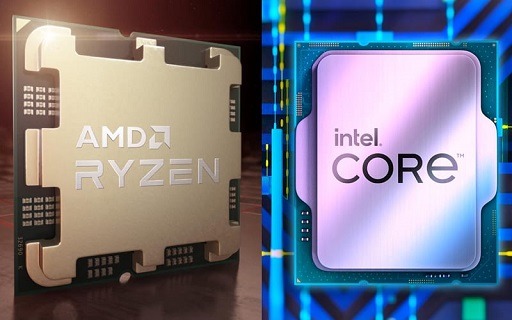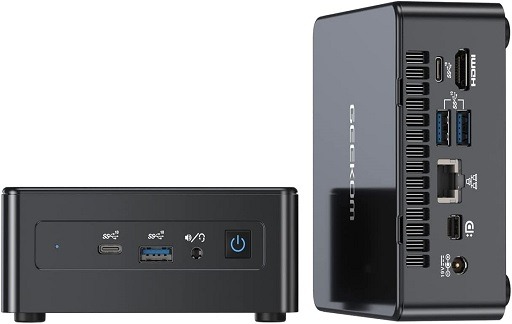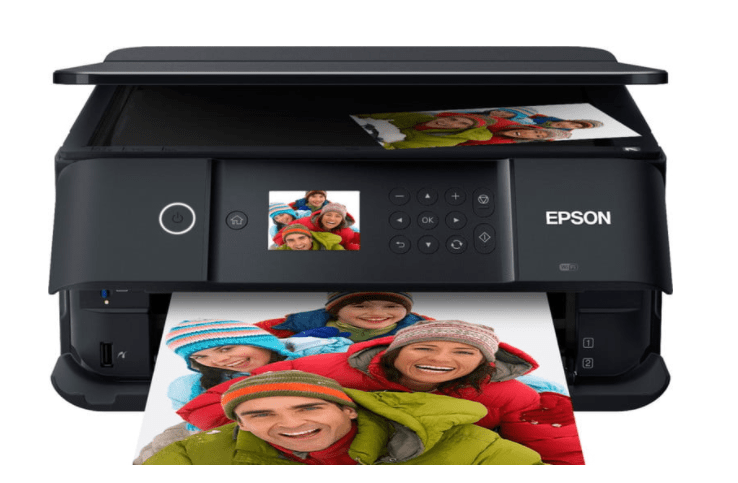Ryzen 7000 vs Intel Raptor Lake: AMD and Intel are back in the CPU boxing ring, each vying to release the best processor. AMD has released the Ryzen 7000 series, which is based on the new Zen 4 architecture and TSMC’s cutting-edge 5nm node and aims to reclaim the performance crown that Intel’s 12th-generation CPUs have taken.
To maintain its lead, Intel launched its 13th-generation series, codenamed Raptor Lake, which is a refinement of the 12th-generation, with more cores and L2 cache than before. The strategies employed by each company could not be more dissimilar. With the reviews in, we can finally determine which CPUs will win this generation.

Architectures
The new Zen 4 architecture was introduced with AMD’s Ryzen 7000 CPUs, and the big ticket upgrades are 1MB of extra L2 cache per core (double from Zen 3), new AI instructions, and the use of TSMC’s new, enhanced 5nm node. All of these enhancements, as well as several minor changes, promise a 13% increase in instructions per clock (or IPC) and a massive clock speed increase, from 4.9GHz on Ryzen 5000 to 5.7GHz on top Zen 4 CPUs.
Aside from the Zen 4 core, the IO die includes an RDNA2 iGPU, which brings graphics to chiplet Ryzen CPUs for the first time. However, these graphics are not intended for gaming and are more suited to PC users who do not require discrete graphics (like business PCs, for example). DDR5 memory and PCIe 5.0 for graphics and storage are also supported by the Ryzen 7000.
Raptor Lake CPUs are essentially larger and more refined than previous-generation Alder Lake CPUs, with three key improvements: higher-clocked cores, more cores, and more cache. All of this has been accomplished without the use of a new process or architecture, as AMD has done; Intel continues to use its Intel 7 process (also known as 10nm) and the same E-cores seen in Alder Lake. However, the P-cores have been updated with the new Raptor Cove microarchitecture.
When it comes to clock speed, the Core i9-13900P-cores K’s can hit 5.8GHz out of the box, which is 600MHz faster than the 12900K and 100MHz faster than the 7950X. The E-cores, on the other hand, receive a lower boost of 400MHz, which is still quite adequate. This increased clock speed, however, does not come cheap, as it necessitates significantly more power.
Raptor Lake also has a significant increase in core count, but it’s the smaller E-cores that are more efficient but also much slower than the larger P-cores. However, it makes sense for Intel to add more E-cores because the P-cores are primarily for single-threaded tasks and the E-cores are adequate for multithreaded workloads.
However, one of the most significant changes in the cache, which can speed up various types of workloads, particularly games. The L2 cache on the 13900K is double that of the 12900K. This is not how AMD designs its CPUs; Ryzen CPUs have the majority of their cache in L3, but Raptor Lake’s L2 cache is nearly as large as its L3.
You may also like AMD Radeon RX 6500 XT: The Power Color Gaming Graphics Card
Ryzen 7000 vs Intel Raptor Lake: Performance
Early on, it appeared that the performance gap in this generation would be very narrow, as AMD was catching up by making significant technological advances, while Intel didn’t have many options other than to improve on Alder Lake. The big question was whether Intel could improve Alder Lake sufficiently to maintain its lead. The reviews for both the Ryzen 9 7950X and the Core i9-13900K are finally in, and we can finally reach a conclusion: it’s a genuine tie. Indeed, it’s difficult to recall another generation in which AMD’s and Intel’s flagship CPUs were so evenly matched.
Let’s start with applications that rely on fast CPUs. The 7950X scored around 37,000 points in multithreaded rendering and 2,000 points in single-threaded rendering in Cinebench R23, one of the most popular benchmarks to run. The 13900K outperformed this by a small margin, with a multithreaded score of around 40,000 and a single-threaded score of 2,200. The tables are turned in 7-Zip, as the 7950X has significantly faster compression and decompression speeds than the 13900K. For these two CPUs, it’s won some, and lost some, but usually not by much.
However, in other tests, the 7950X and 13900K are almost evenly matched, down to single-digit percentage points. The 7950X scored 23,764 in Geekbench 5 multithreaded, while the 13900K scored 23,786. That’s only a 22-point difference or less than 1%. The gap was slightly larger in the single-threaded test. The 13900K finished one second faster than the 7950X in Handbrake, with times of 37 and 38 seconds, respectively. It’s difficult to overstate how similar these CPUs are in terms of performance.
These two CPUs perform nearly identically in games. The only game with a significant performance difference was Far Cry 6, where the 7950X achieved 153 frames per second (fps) compared to the 13900K’s 142 fps, a difference of only 8%. In Assassin’s Creed Valhalla, the difference was four frames; in Red Dead Redemption 2, it was only one frame; and in Cyberpunk 2077, both CPUs achieved the same frame rate.
In fact, only one gaming-related benchmark revealed a significant difference between these two CPUs: 3DMark Fire Strike. The 13900K finished with nearly 39,000 points, falling short of the 7950X’s 43,000. However, in the more recent Time Spy benchmark, the 7950X scored 19,113 points and the 13900K scored 19,839.
It’s nearly impossible to pick a winner in terms of overall performance. Each CPU appears to have distinct strengths and weaknesses, but these only appear in a few applications, such as 7-Zip, which performs better on Ryzen 7000, and Cinebench R23, which performs better on Raptor Lake. However, when it comes to value, Intel is clearly the winner, as 13th-generation CPUs are significantly less expensive than Ryzen 7000 chips.
You may also like Intel Core i9-13900K: Desktop Processor with 24 cores
Ryzen 7000 vs Intel Raptor Lake: Motherboards
AMD introduced three new Ryzen 7000 chipsets: the X670E, X670, and B650. The X670E chipset is designed for hardcore overclockers, the X670 for the average high-end user, and the B650 for lower-end to midrange users. AMD hasn’t announced a successor to the A520 chipset, but it was a late addition to the 500 series, so it could arrive after the Ryzen 7000. Because Intel’s current-generation boards are also in the 600 series, we’ll use socket names, so AM5 for AMD and LGA1700 for Intel.
DDR5, PCIe 5.0, up to 14 USB ports at 20Gbps, Wi-Fi 6E, and Bluetooth 5.2 are all supported by all AM5 motherboards. The maximum number of displays that can be driven by the motherboard has also been increased from two on the 500 series to four on AM5. Overclocking support has not changed, and AM5 owners can overclock on motherboards such as the B650, X670, and X670E. AM5 motherboards are also compatible with AM4 coolers, which is ideal for any AMD user looking to upgrade when the Ryzen 7000 processor is released.
AMD has also introduced EXPO memory overclocking, which is essentially AMD’s version of Intel’s Extreme Memory Profile (XMP).
Raptor Lake is backward compatible with Alder Lake motherboards from the previous generation, as well as next-generation motherboards using the Z790 chipset, which adds PCIe 5.0 to the M.2 and PCIe slots. Like AMD’s Ryzen 7000 boards, Intel’s LGA 1700 motherboards (new or old) support DDR5 or DDR4 (depending on the motherboard version), PCIe 5.0, Wi-Fi 6E, and Bluetooth 5.2. On a feature level, neither AMD nor Intel has a significant advantage.
One advantage for Intel is that all of its chipsets and motherboards support PCIe 5.0 graphics on the x16 slot. Even the most basic LGA1700 board can accommodate a next-generation PCIe 5.0 GPU. Meanwhile, PCIe 5.0 graphics are only available on higher-end AMD AM5 motherboards.
Intel has a significant price advantage in motherboards because previous-generation boards designed for Alder Lake CPUs are also compatible with Raptor Lake CPUs. Although AMD has launched its B650 chipset, which is supposed to be midrange in price, it is currently much more expensive than both previous B-series chipsets as well as Intel’s H610 and H670 motherboards. Furthermore, Raptor Lake users can choose DDR4 memory over DDR5, whereas AM5 and Ryzen 7000 only support DDR5. As a result, Raptor Lake’s platform costs significantly less than Ryzen 7000.
When it comes to features, AMD and Intel motherboards are roughly equal, but Raptor Lake outperforms them when it comes to value.
You may also like AMD Ryzen 6000 CPU: The Performance Punch Processor
Ryzen 7000 vs Intel Raptor Lake: Pricing and availability
Ryzen 7000 was released on September 27, nearly a month before Raptor Lake. Allowing AMD a month to itself wasn’t ideal for Intel, but we must consider pricing in this case.
AMD has so far announced four different processors for the midrange and high-end markets:
- Ryzen 9 7950X, $699
- Ryzen 9 7900X, $549
- Ryzen 7 7700X, $399
- Ryzen 7 7600X, $299
The Ryzen 7000 pricing structure is an improvement over the Ryzen 5000 pricing structure, but it still doesn’t offer anything for buyers looking for something a little cheaper. Ryzen 7000 CPUs with 3D V-Cache are also not yet available, but AMD has confirmed that they will be soon. At AMD’s CES 2023 presentation in January, we’re hoping to hear something about cheaper or V-Cache-equipped Ryzen 7000 CPUs.
Most of us expected 13th-generation CPUs to be more expensive than 12th-generation Alder Lake chips. Since 2017, Intel has raised prices with each generation, and because Raptor Lake has many more cores than Alder Lake (increasing manufacturing costs), another round of price increases appeared likely.
Thankfully, most of us were wrong, and 13th-generation CPUs are priced similarly to 12th-generation CPUs. Intel, like AMD, has only released midrange to high-end CPUs, but new models are expected later.
- Core i9-13900K, $589
- Core i7-13700K, $409
- Core i5-13600K, $319
But the thing is, Raptor Lake is increasing core counts across the board, and Intel isn’t skimping. The end result of Intel’s pricing strategy is that the Core i9-13900K undercuts the Ryzen 9 7950X by more than $100, which is significant given that the 13900K could dethrone the 7950X’s brief reign (but more on that later). The Core i7-13700K is also an intriguing CPU, as it has similar specs to the Core i9-12900K and costs roughly the same as the Ryzen 7 7700X.
You may also like Best RAM
The price and performance
On a performance or feature level, there isn’t much of a difference between Ryzen 7000 and Raptor Lake, which may be unprecedented. There will undoubtedly be cases where one is noticeably better than the other, but on average, the flagship Ryzen 9 7950X and Core i9-13900K are equally capable.
It all boils down to the price for this generation. Although the 7950X can compete with the 13900K, it is also $100 more expensive. We must also consider that Ryzen 7000 CPUs have much higher platform costs than Raptor Lake due to the need for expensive DDR5 memory and a lack of affordable motherboards. This may not be a big deal for users interested in flagship CPUs, but anyone interested in a midrange CPU like the Ryzen 5 7600X or the Core i5-13600K will take notice, making Intel the clear winner in many people’s eyes.
Would you like to read more about Ryzen 7000 vs Intel Raptor Lake-related articles? If so, we invite you to take a look at our other tech topics before you leave!
![]()












